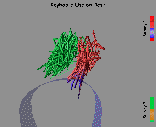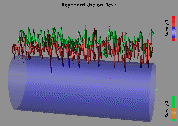

- detailed research study description
- research test conditions
- additional images from the study
- details of the keyboard system


|

|
|
Click on the images to enlarge.
Carpal Tunnel Syndrome (CTS) has been linked to using computer keyboards in ways that force the wrist back during typing and resting. Repeated extremes of wrist extension can put excessive pressure on the median nerve as it passes through the carpal tunnel of the wrist, and this impairs nerve function and eventually results in injury. Human Factors research at Cornell is investigating ways of working with the wrists in a neutral posture to help to prevent CTS.
In a recent study, Alan Hedge, professor of Human Factors in the Dept. of Design and Environmental Analysis, and director of the Human Factors Laboratory at Cornell, worked with Dr. Daniel McCrobie, a corporate ergonomist at Honeywell Inc., to study 38 professional office workers. First, 23 workers were tested using various combinations of traditional keyboards on desk or conventional trays, with or without wrist rests. These same volunteers were again tested three weeks after using a Preset Tiltdown Keyboard Systems (NSKS). Fifteen other volunteers, who served as a control group, were also tested twice although no changes were made to their workstations.
Vertical and lateral wrist positions were dynamically recorded at 5Hz using an exoskeleton measuring device. Scientific visualization of the data, using the Data Explorer program, allowed researchers to see precisely how different arrangements affected wrist movements. With these tools, it became obvious that the Preset Tiltdown Keyboard System (NSKS) arrangement consistently improves wrist posture during keyboard use.
Among the study's main findings were that with the Preset Tiltdown system:
Click on the images to enlarge, or here for mpeg movie (75 frames).
Visualization of data for individual subjects shows wrist Ulnar/Radial (lateral motion) and Extension/Flexion (vertical motion) angular deviation measurement data for the right hand as the subject types a standard text passage. The motion of the hand is represented by a "data pipe" which tracks wrist movements in three-dimensional space as the person types. Time, represented by the length of the tube along one dimension, is "frozen" in the still images. The growth of the tube in the mpeg movie shows how the data accumulated over time. The large elliptical blue tube indicates that region of the Ulnar/Extension plane that from empirical data should represent little or no risk, due to inferred low pressure in the carpal tunnel -- this is informally called the "Neutral Zone." For each subject there are two data pipes in each image, one representing wrist movements before and one after treatment. Variation in color along an individual data pipe correlates outside of the neutral zone.
Click on the images to enlarge, or here for mpeg movie (143 frames).
Visualization of grouped data for control and test groups shows concurrent wrist Ulnar/Extension angular deviation measurement data for all subjects in one treatment group, collapsed over time, collected into a two-dimensional matrix of "bins." The count of data points in each bin is extended into the third dimension to form a three-dimensional surface. The height of the colored surfaces represents comparative number of data points, for each combination of Ulnar/Extension angular deviation position. The red box indicates that portion of the Ulnar/Extension plane assumed to represent significant risk of injury, due to inferred high pressure in the carpal tunnel. The curved elliptical wall indicates the neutral zone, i.e. that region of the Ulnar/Extension plane assumed to represent little or no risk, due to inferred low pressure in the carpal tunnel.
The yellow surfaces represent Survey 1, data collected prior to any treatment. The blue surface represents Survey 2, data collected from the same subjects 3 weeks after using the Preset Tildown keyboard system (NSKS).
Researchers: Alan Hedge and Singe Morimoto, Department of Design and Environmental Analysis, Cornell University, ah29@cornell.edu
Hardware Used:IBM RS/6000
Software Used: IBM Data Explorer
Visualization Credits: Simonetta Rodriguez, Bruce Land, Cornell Theory Center, bruce@tc.cornell.edu